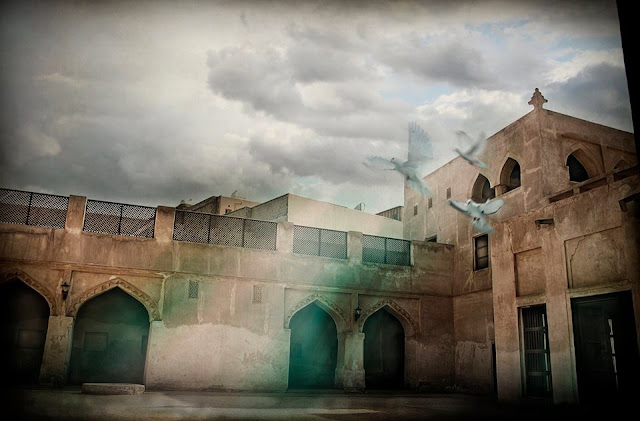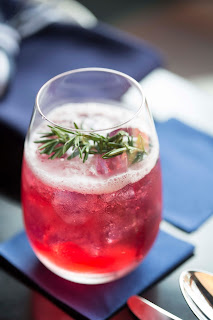Helping you make the most of your first date—whatever
the type you’re looking for—is our selection of restobars across the city that
offer you everything from the best romanctic views in Mumbai to places where
the two of you can show of your competitive side playing boardgames!
By
Raul Dias
For the music junkies
Raasta
This fourth floor, twin levelled restobar is perfect for a date night (or even afternoon!) where music is the binding factor. Offering up a selection of live music gigs with a slant towards Reggae, this place regularly hosts both local and international bands like BLOT that perform on its specially built balcony stage. With a vibe that’s pure Caribbean from its easy, laid back décor to its menu that has everything from meter high cocktails called bongtails, served up in…yes, you guessed right, bongs, to scrumptious finger food like jerked chicken and jambalaya, make sure all roads lead to Raasta for that ultimate first date.
Where: 4th Floor, Rohan plaza, Ram Krishan Nagar, Road no. 5, Khar
Call: 8655000811
Timings: 12pm to 1:30am
Approx. Cost for two with drinks and bar bites: Rs 2,000
Raasta
This fourth floor, twin levelled restobar is perfect for a date night (or even afternoon!) where music is the binding factor. Offering up a selection of live music gigs with a slant towards Reggae, this place regularly hosts both local and international bands like BLOT that perform on its specially built balcony stage. With a vibe that’s pure Caribbean from its easy, laid back décor to its menu that has everything from meter high cocktails called bongtails, served up in…yes, you guessed right, bongs, to scrumptious finger food like jerked chicken and jambalaya, make sure all roads lead to Raasta for that ultimate first date.
Where: 4th Floor, Rohan plaza, Ram Krishan Nagar, Road no. 5, Khar
Call: 8655000811
Timings: 12pm to 1:30am
Approx. Cost for two with drinks and bar bites: Rs 2,000
For the city’s most romantic views
Asilo
As Mumbai’s much sought after rooftop destination at the St Regis Mumbai, Asilo is known for its decadent sundowners, lavish brunches and absolutely A-list parties. But it is also one of the most—if not THE most—picturesque places, offering unmatched vistas of the island city below. Impress your date by showing them the city from almost 40-stories high up as you two sip on cocktails like the rum and coconut based Aqua, while nibbling on sushi and smoked salmon rillettes. A great way to start something new, what say?
Where: Level 37, 462, Senapati Bapat Marg, Lower Parel
Call: 61628031
Timings: 5:30pm to 1:30am
Approx. Cost for two with drinks and bar bites: Rs 4,500
Asilo
As Mumbai’s much sought after rooftop destination at the St Regis Mumbai, Asilo is known for its decadent sundowners, lavish brunches and absolutely A-list parties. But it is also one of the most—if not THE most—picturesque places, offering unmatched vistas of the island city below. Impress your date by showing them the city from almost 40-stories high up as you two sip on cocktails like the rum and coconut based Aqua, while nibbling on sushi and smoked salmon rillettes. A great way to start something new, what say?
Where: Level 37, 462, Senapati Bapat Marg, Lower Parel
Call: 61628031
Timings: 5:30pm to 1:30am
Approx. Cost for two with drinks and bar bites: Rs 4,500
For the (board game) players!
MRP
Claiming to be Mumbai’s… nay, India’s first drinking games bar, MRP or My Regular Place for the uninitiated is a fun, casual mid-town restobar where the two of you can have a memorable first date playing all sorts of games with each other. From snakes and ladders to beer pong, each table here comes with its own box of board games with fun forfeits and wins. Among the drinks, make sure to try the Tiki Tori that’s made up of pineapple juice and three types of rums, while you fight over the last pork belly bao. Remember all is fair in love and games!
Where: Dharamputra Pritam Estate, Dr Baba Saheb Ambedkar Rd, Lokmanya Tilak Colony, Dadar (e)
Call: 9699990036
Timings: 12pm to 3:30pm and 6pm to 1am
Approx. Cost for two with drinks and bar bites: Rs 1,500
MRP
Claiming to be Mumbai’s… nay, India’s first drinking games bar, MRP or My Regular Place for the uninitiated is a fun, casual mid-town restobar where the two of you can have a memorable first date playing all sorts of games with each other. From snakes and ladders to beer pong, each table here comes with its own box of board games with fun forfeits and wins. Among the drinks, make sure to try the Tiki Tori that’s made up of pineapple juice and three types of rums, while you fight over the last pork belly bao. Remember all is fair in love and games!
Where: Dharamputra Pritam Estate, Dr Baba Saheb Ambedkar Rd, Lokmanya Tilak Colony, Dadar (e)
Call: 9699990036
Timings: 12pm to 3:30pm and 6pm to 1am
Approx. Cost for two with drinks and bar bites: Rs 1,500
For the urbane sophisticate
Theory
With its almost 50 shades of black interiors, including a mammoth 100 ft-long pressed charcoal island bar, Theory oozes undiluted, slinky sex appeal and is thus the perfect place for a first date that’s designed to impress and be impressed by. Dress up to the nines and wet your lips with libations like the Asian Mojito, a vermouth and gin based concoction while nibbling on delectable bar bites like the paper thinly-sliced prawn carpaccio anointed with a yuzu-sesame-soy sauce. Decadence with a capital ‘D’, this!
Where: Unit 1 C Wing, Trade World, Kamala Mills, Senapati Bapat Marg, Lower Parel
Call: 66666506
Timings: 12pm to 4pm and 7pm to 1:30am
Approx. Cost for two with drinks and bar bites: Rs 3,750
Theory
With its almost 50 shades of black interiors, including a mammoth 100 ft-long pressed charcoal island bar, Theory oozes undiluted, slinky sex appeal and is thus the perfect place for a first date that’s designed to impress and be impressed by. Dress up to the nines and wet your lips with libations like the Asian Mojito, a vermouth and gin based concoction while nibbling on delectable bar bites like the paper thinly-sliced prawn carpaccio anointed with a yuzu-sesame-soy sauce. Decadence with a capital ‘D’, this!
Where: Unit 1 C Wing, Trade World, Kamala Mills, Senapati Bapat Marg, Lower Parel
Call: 66666506
Timings: 12pm to 4pm and 7pm to 1:30am
Approx. Cost for two with drinks and bar bites: Rs 3,750
For the shallow pocketed
The Beer Café
Don’t worry at being called a cheapskate. No one said your first date has to break the bank! With beer starting as low as Rs 169 per pint, your money will go a long way at this fun, cool-n-casual beer café chain that’s done up in cheery shades of yellow with fun bric-a-brac décor strewn about the place. Not fans of beer? TBC offers a great range of inexpensive, basic cocktails like Screwdrivers and Mojitos that pair with bar bites like buffalo chicken wings and cheese poppers.
Where: Shop 6-7, Ground Floor, Cambata Building, 42, Maharishi Karve Road, Churchgate. (also at Powai, Andheri (w), Kamala Mills, Mahim, High Street Phoenix and even CSIA Airport)
Call: 66153510
Timings: 11am to 12:30am
Approx. Cost for two with drinks and bar bites: Rs 850
The Beer Café
Don’t worry at being called a cheapskate. No one said your first date has to break the bank! With beer starting as low as Rs 169 per pint, your money will go a long way at this fun, cool-n-casual beer café chain that’s done up in cheery shades of yellow with fun bric-a-brac décor strewn about the place. Not fans of beer? TBC offers a great range of inexpensive, basic cocktails like Screwdrivers and Mojitos that pair with bar bites like buffalo chicken wings and cheese poppers.
Where: Shop 6-7, Ground Floor, Cambata Building, 42, Maharishi Karve Road, Churchgate. (also at Powai, Andheri (w), Kamala Mills, Mahim, High Street Phoenix and even CSIA Airport)
Call: 66153510
Timings: 11am to 12:30am
Approx. Cost for two with drinks and bar bites: Rs 850
For a cozy night out
Swey
Enjoy these last few fleeting days of rain as the two of you cuddle up together on one of Swey’s rather comfortable couches and watch the calm sea below from this not-so-high rooftop Worli restobar. Done up in soothing shades of white and ivory, the huge 15,000 sq ft space is divided up into several smaller nooks, each exuding a cozy vibe. Drinks like the kale-redolent Kale-n-Hearty pair superbly with nibbles like the American fried mac-n-cheese bars and the Goan stuffed squids.
Where: 4th Floor, Atria Mall, Opposite Poonam Chambers, Doctor Annie Besant Road, Worli
Call: 9820436666
Timings: 12pm to 1:30pm and 7pm to 12am
Approx. Cost for two with drinks and bar bites: Rs 1,750
Swey
Enjoy these last few fleeting days of rain as the two of you cuddle up together on one of Swey’s rather comfortable couches and watch the calm sea below from this not-so-high rooftop Worli restobar. Done up in soothing shades of white and ivory, the huge 15,000 sq ft space is divided up into several smaller nooks, each exuding a cozy vibe. Drinks like the kale-redolent Kale-n-Hearty pair superbly with nibbles like the American fried mac-n-cheese bars and the Goan stuffed squids.
Where: 4th Floor, Atria Mall, Opposite Poonam Chambers, Doctor Annie Besant Road, Worli
Call: 9820436666
Timings: 12pm to 1:30pm and 7pm to 12am
Approx. Cost for two with drinks and bar bites: Rs 1,750
For the nervous dater
The Bandra Project
Worried about making awkward conversation on your first date? Fear not! This brand new Bandra hot-spot is so buzzing and lively, that you won’t get a chance to fumble through the date. The fun, affable staff will take the edge of your first date with their quick and efficient service as they ply you with fun cocktails given a decidedly Bandra spin like the cinnamon-citrus Bandra Fest and the lavender-gin-based Joggers Park. And don’t forget to let the small plates like the chorizo-topped ragi pancakes and the prawn potato chops do all the talking, if things get a little awkward!
Where: 602, Doctor BR Ambedkar Road, Pali Hill, Bandra
Call: 62506800
Timings: 8:30am to 1:30am
Approx. Cost for two with drinks and bar bites: Rs 2,500
The Bandra Project
Worried about making awkward conversation on your first date? Fear not! This brand new Bandra hot-spot is so buzzing and lively, that you won’t get a chance to fumble through the date. The fun, affable staff will take the edge of your first date with their quick and efficient service as they ply you with fun cocktails given a decidedly Bandra spin like the cinnamon-citrus Bandra Fest and the lavender-gin-based Joggers Park. And don’t forget to let the small plates like the chorizo-topped ragi pancakes and the prawn potato chops do all the talking, if things get a little awkward!
Where: 602, Doctor BR Ambedkar Road, Pali Hill, Bandra
Call: 62506800
Timings: 8:30am to 1:30am
Approx. Cost for two with drinks and bar bites: Rs 2,500
(An edited version of this article appeared in the 28th August 2017 issue of the evening edition of Mid-Day newspaper, India)






















